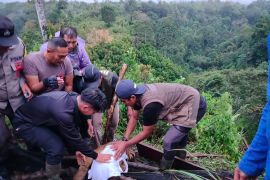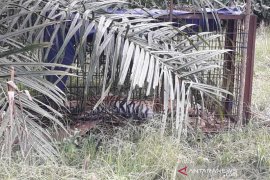Batang Anai Sub-district Head Syofriyon said the tiger had been found inside a wild boar trap located around four kilometers from a human settlement.
"Frightened local villagers and wild boar hunters immediately shot the tiger without consultation with the local authorities," he said in Padangpariaman, on October 17.
Batang Anai Police Chief Adjunct Commissioner Ali A Nazar said the tiger`s body was missing, but his office and the West Sumatra Nature Conservation Agency (BKSDA) are currently investigating the case.
Ali said although the tiger had been trapped by accident, he would take legal measures if there was violation that led to the death of the protected animal.
Sumatra`s tropical rain forest is a home of around 400 endangered Sumatran tigers. Because their habitat has been destroyed, the wild animals often enter villages and come into conflict with villagers.
In Bengkulu Province, Sumatra Island, at least 10 man-versus-tiger conflicts occurred this year, causing the death of one person and one tiger.
"We have recorded 10 conflicts between humans and tigers that happened in areas between villages and forests this year," Amon Zamora, the head of the Bengkulu BKSDA said last September.
The conflicts had occurred among other things in the border area between Air Ipuh forest and Malin Deman sub district, Muko Muko District, he said.
On October 12, 2011, a Sumatran tiger attacked and injured Iwal (40), a resident of Pino Baru, Cawang village, Lubuk Sandi sub district, Seluma District, Bengkulu Province.
Iwal was attacked by the tiger when he was working in his coffee garden located inside the Bukit Sanggul protected forest area. He was injured in his leg and thigh but he managed to free himself from the animal`s claws and run to safety,
Around three weeks ago, at the same location, a young man working as a coffee planter, was killed by a tiger.
Supartono of the Bengkulu BKSDA said his office is now dealing with the wild animal attack case.
"The fact that we saw in the field, the location where the attack occurred, is indeed inside Bukit Sanggul protected forest. The villagers who were attacked, have opened gardens inside the forest area," he said.
BKSDA has warned local villagers not to encroach the Bukit Sanggul protected forest area in order to prevent a conflict with the jungle`s wild animals, which include tigers and Sumatran elephants.
The tiger population in the wild in Sumatra is believed to have dwindled to only 400 heads due to illegal logging in industrial forest areas, a Greenpeace activist said.
"We from Greenpeace urges all industrial forest companies, especially those operating in Riau Province, to stop their illegal logging activity for the sake of our grand children in the future," Rusmadya, a Greenpeace forest campaign coordinator , said recently.
Because their habitats have been destroyed, the wild animals often enter villages and come into conflict with villagers, he said. He also urged the central government to seriously deal with the problem in order to preserve the endangered animal.
"We should remember that forests is a sacred place according to our ancestors. If we destroy forest, it means we also destroy the traditions and beliefs of our ancestors," he said.
In July 2011, several Greenpeace activists accompanied the Riau BKSDA officers went to the province in order to rescue a trapped Sumatran tiger.
Unfortunately, the rescue effort failed to save the tiger which had been trapped for seven days and had been too weak to survive.
Greenpeace is currently launching a month-long "Save Tigers` Home" Tour on Sumatra Island.
"The goal of the month-long tour is to highlight the ongoing destruction of Sumatra`s last remaining forests and to mobilize the public to help stop this rampant deforestation. Sumatra`s last remaining forests are the key habitat for the critically endangered Sumatran tiger," Greenpeace Southeast Asia said in a press statement recently.
Local community leaders in Jumrah Village, Rokan Hilir, Riau Province, blessed five tiger-suited Greenpeace activists who are touring Sumatra on motorbikes, with a `Tepung Tawar` ceremony to ward off evil spirits during the tour.
"Now Sumatra tigers often wander in to our village and we are frightened, there have been several recent casualties. The tigers come to our village because their home, the forest, is being destroyed by pulp and paper companies. We hope this Greenpeace Tour can convey our problems to the authorities, and especially the land tenure conflict we are dealing now," said Jumrah Chief Leader Sukardi Ahmad.
The "Save Tiger`s Home" Tour was soft launched in Jakarta on 16th September 2011, with a `Silat Harimau` martial art show, photo exhibition and speeches by prominent figures from Indonesian civil society, urging the government to review existing concessions, protect peat land and the forestry sector to implement a zero deforestation policy in their operations.
"On this tour, Greenpeace activists will bear witness to the forest destruction to show the public the scale of the problem and what is at stake if it is not stopped. We are asking all people to help us monitor the destruction and join us to save Indonesia`s rain forests by becoming a `Tiger Eye`", said Rusmadya Maharuddin, Greenpeace Southeast Asia Forests Campaigner.
In Tesso Nillo National Park, Pelalawan, Riau Province, also on Sumatra Island, WWF jointly with Greenpeace launched a campaign to save the Sumatran tigers and elephants (Elephas maximus sumatranus).
Chief of WWF Flaying Squad Training at Tesso Nilo National Park (TNTN) Syamsuardi said in September 2011, the two NGOs wished to save the forest environment constantly facing deforestation by timber companies in Riau.
"We have the same mission. We both want to save the Sumatran tigers initiated by Greenpeace and Elephants by WWF," he said.
According to Syamsuardi, Sumatran tigers and elephants are both forest sacred guardians which have to be protected. (*)
Reporter: By Fardah
Editor: Kunto Wibisono
Copyright © ANTARA 2011









